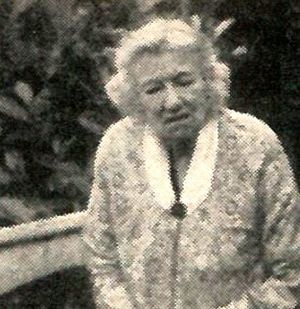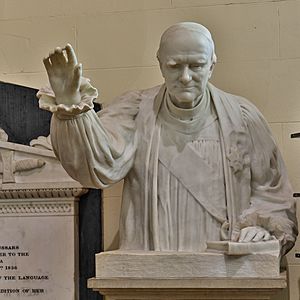Kathleen Trousdell Shaw facts for kids
Quick facts for kids
Kathleen Trousdell Shaw
|
|
|---|---|
 |
|
| Born | 1865 London, England
|
| Died | 1958 (aged 92–93) Buckinghamshire, England
|
| Nationality | British, Irish |
| Alma mater |
|
| Known for | Painting, sculpture |
Kathleen Trousdell Shaw (1865–1958) was a talented artist from both Britain and Ireland. She was known for her sculptures and was even made an honorary member of the Royal Hibernian Academy, a special art group in Ireland.
Contents
Kathleen Shaw's Early Life
Kathleen Shaw was born in London, England, in 1865. Her father, Alfred Shaw, was a doctor from Ireland, and her mother was Annie Birch. Kathleen had an older sister, Helen, who became an actress. Another sister, Mary Helen, was also an artist. Her older brother, Alfred, was a doctor and studied insects.
Kathleen grew up in Ireland. When she was just 10 years old, she started studying drawing and sculpture at the Metropolitan School of Art, Dublin. She was very good and won many prizes! At 15, she traveled to Paris, France, to study at a famous art school called the École des Beaux Arts.
Kathleen started losing her hearing when she was 5. By the time she was 17, she was mostly deaf. People in Dublin helped raise money so she could study with a famous sculptor named Charles Desvergnes in Rome, Italy. There, she met important people, like Lord Dufferin, who was the British Ambassador to Italy.
Kathleen Shaw's Art Career

Kathleen Shaw also studied with another artist named Alfred Gilbert. After her time in Rome, she worked for a while at the British Museum. Then, she returned to Ireland. In 1899, she lived in London at a place called York Street Chambers. This building was a special home for single professional women.
In 1914, Kathleen advertised that she taught drawing and painting. She mentioned that she had won medals at a teaching studio in London called Atelier Ludovici. This studio mostly taught professional women artists. She also shared details about her art certificates and her experience teaching in schools for girls and boys.
Kathleen was connected to a group called the Suffrage Atelier, which was active from 1909 to 1914. This group worked to help women gain the right to vote. She might have been a member of this group. Around this time, she had an art studio in Hampstead, London. By 1911, she was living with Rosamund Venning, who was a translator and a friend of a writer named Hannah Lynch. Kathleen and Rosamund had once traveled to Athens, Greece, together.
Later Life and Legacy
After World War I, Kathleen Shaw moved to a quiet village called Cadmore End in Buckinghamshire, England. She lived there in a cottage called Pitt Cottage. When Rosamund Venning passed away in 1928, she chose Kathleen to manage her affairs.
Kathleen Shaw passed away in 1958. Towards the end of her life, her eyesight also failed. This meant she could not see or hear, and she could only communicate with her friends through touch. She spent her last years in a hospital. A special article about her life was written by Mrs. B. R. James in Silent World, a magazine for people with hearing loss.
Notable Artworks
Kathleen Shaw often showed her art in exhibitions, including at the famous Royal Academy. She created many sculptures of people's faces, especially of church leaders and important noble families. She also made art inspired by old stories and books.
In 1900, she showed two of her works at the Women's Exhibition in Earl's Court, London. These were called "Pomona's Child" and a sculpture of the head of Wilbraham Egerton, 1st Earl Egerton. Years later, an art review praised her, saying she was one of the few artists who always wanted to show only her very best work.
Kathleen was also asked to create large public artworks. She designed a memorial for the Royal Irish Fusiliers, a military group, to remember their soldiers who died in the Second Anglo-Boer War. This memorial was revealed in 1906 in Armagh, Ireland. You can see one of her sculptures, a portrait of Rev. Francis William Tremlett (who died in 1913), in St Peter's church in Belsize Park, London.
She also designed a war memorial for the village of Cadmore End, where she lived. This memorial was dedicated in 1920. It was a bronze cover for a special water basin used in churches called a baptismal font. In 1921, she signed a beautiful stained glass window that was part of a war memorial at the church of Malew, on the Isle of Man.
Awards and Recognition
Kathleen Shaw made history by being the first female sculptor to be chosen as a member of one of the important British art academies. The article written after her death said she was "a member of the Royal Hibernian Academy, the first woman ever elected to that body." However, this was not quite right. The very first female honorary member was Margaret Green, chosen in 1878. The Academy started letting female students join in 1893. The article also incorrectly said Kathleen was elected in 1907. Based on records, she was elected in 1900, making her the third female member after Sarah Purser, who was elected in 1890.

